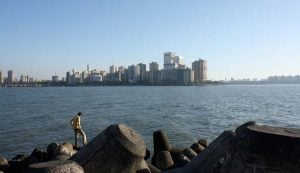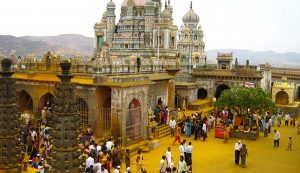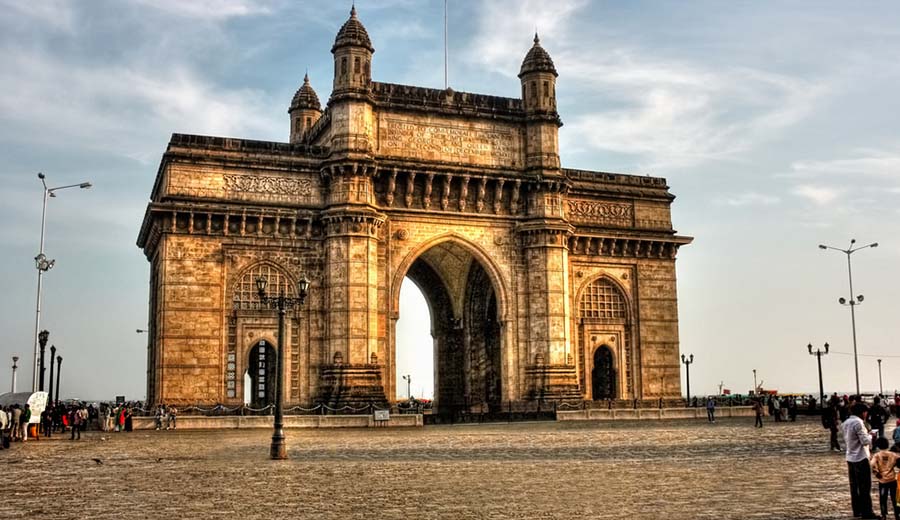Gateway of India in Mumbai
Gateway of India in Mumbai- the colossal monument
This is the most popular destination when someone plans to visit Mumbai. It is situated in Colaba district of south Mumbai. The structure was built in the year 1924. It overlooks the harbor of Mumbai which is along the Arabian Sea in Apollo Bunder Waterfront. It was mainly constructed to offer a welcome to King George V and Queen Mary while they visited India. This gateway is also remarkable as the last troop of British left our country through The Gateway of India in Mumbai. The gateway is nicknamed as Taj Mahal of Mumbai and serves as a symbol of the rich heritage of India. The view of the gateway at night from the sea is really impressive and equals to the beauty of the marine drive, queen’s necklace. This place is a must-visit while in Mumbai as it comes first among all other destinations.
History
The Gateway of India is a monumental archway located in Mumbai, India. It was built in 1911 to commemorate the visit of King George V and Queen Mary to Bombay, as Mumbai was then known. The Gateway was designed by the British architect George Wittet, and is considered a key example of Indo-Saracenic architecture, a style that blends Indian and Islamic architectural elements with elements of European design.
Construction of the Gateway of India began in 1911 and was completed in 1924. The archway stands 26 meters tall and is made of yellow basalt stone, with intricate carvings and embellishments. Over the years, the Gateway of India has become a symbol of Mumbai and an important landmark in the city.
In 1947, the last British troops left India through the Gateway of India, marking the end of British colonial rule. Today, the Gateway of India is a popular tourist destination, and visitors come from all over the world to admire its beauty and significance. In recent years, the surrounding area has been developed into a bustling hub filled with street vendors, shops, restaurants, and cafes, making it a vibrant and exciting place to explore.
Structural layout Gateway of India in Mumbai
The structure exposes the mixed architectural influence of Hindu, Muslim, and Roman arch. It stands to a height of 26 meters with basal, stone, and concrete from local sources. The central dome has a diameter of 48 feet accompanied by a 83 feet high apex. The honeycomb structure with four series creates a unique symmetry. The Arabian Sea is best viewed from the steps behind the colossal archway.
Where to stay
Although finding a place to stay in Mumbai is not at all a problem still here are some options to help to ease your search. Besides the luxurious Taj Mahal Hotel, you can choose a regent hotel. Hotel Suba palace, abode Bombay, hotel diplomat for a suitable homestay.
Nearby restaurants
The Gateway of India is located in the Colaba area of Mumbai, which is known for its diverse range of dining options. Here are some popular restaurants near the Gateway of India:
- Leopold Cafe: This historic cafe has been serving up hearty meals and drinks since 1871, and is a popular hangout spot for tourists and locals alike.
- Britannia & Co.: Britannia & Co. is a Parsi restaurant that serves authentic Parsi cuisine, including dishes like berry pulao, dhansak, and mutton biryani.
- Bademiya: This popular street-side restaurant serves a variety of Indian street food, including kebabs, tikkas, rolls, and biryanis.
- Kala Ghoda Café: This cafe is located in the heart of the Kala Ghoda art district and serves a range of international and Indian cuisine, including salads, sandwiches, and pasta dishes.
- Coffee by Di Bella: This popular coffee chain serves a range of espresso-based drinks, along with light bites like pastries, cakes, and sandwiches.
These are just a few of the many dining options near the Gateway of India. Whether you’re looking for a quick bite, a sit-down meal, or a drink, you’ll find plenty of options in the area to satisfy your cravings.
Nearby places of interest
Elephanta Caves:

The Elephanta Caves are a network of ancient rock-cut caves located on Elephanta Island, just a short ferry ride away from Mumbai. The caves contain stunning rock sculptures and carvings that date back to the 6th century, depicting Hindu deities and scenes from Hindu mythology. Visitors can explore the Main Cave, which houses the largest and most impressive sculptures, as well as several smaller caves.
Chhatrapati Shivaji Terminus:
Chhatrapati Shivaji Terminus, also known as Victoria Terminus, is a historic railway station and a UNESCO World Heritage Site. It is one of the busiest railway stations in India and a hub for both local and long-distance trains. The station was built in 1887 in Victorian Gothic style and is considered a masterpiece of Victorian architecture. Today, it is a popular tourist destination, and visitors can explore the historic building and learn about its history and significance.
Marine Drive:

Marine Drive is a popular promenade located along the Arabian Sea in Mumbai. The crescent-shaped roadway is a scenic drive that offers breathtaking views of the sea and the city skyline. Marine Drive is also known as the “Queen’s Necklace” due to the street lights that resemble a string of pearls when viewed from a distance at night. The promenade is a popular hangout spot for locals and tourists alike, and is a great place to take a leisurely walk, enjoy street food, and watch the sunset.
Haji Ali Dargah:
The Haji Ali Dargah is a mosque and tomb located on a small island in the Arabian Sea, just off the coast of Mumbai. The shrine is dedicated to the Sufi saint Haji Ali, and is a popular pilgrimage site for Muslims. Visitors can walk to the island during low tide, or take a boat during high tide, to reach the shrine. The Haji Ali Dargah is known for its stunning architecture and peaceful atmosphere and is considered one of the most important landmarks in Mumbai.
Taraporewala Aquarium:
The Taraporewala Aquarium is one of the oldest and largest public aquariums in India, located in Mumbai. It was established in 1951 and is home to a diverse collection of marine and freshwater species, including exotic fish, reptiles, and invertebrates from around the world. Visitors can walk through the aquarium’s many tanks and observe the colorful and fascinating aquatic creatures on display. The Taraporewala Aquarium also offers educational programs and interactive exhibits, making it a great destination for families and children.
Chhatrapati Shivaji Maharaj Vastu Sangrahalaya:
Chhatrapati Shivaji Maharaj Vastu Sangrahalaya, formerly known as the Prince of Wales Museum, is a museum located in Mumbai. The museum houses a vast collection of art, artefacts, and specimens that document the history and culture of India and the wider world. Visitors can explore the museum’s many galleries and exhibitions, which showcase everything from ancient sculptures and paintings to natural history specimens and textiles. The museum also features a beautiful colonial-style building and lush gardens, making it a popular destination for history and culture buffs.
Siddhivinayak Temple:

The Siddhivinayak Temple is a Hindu temple dedicated to the god Ganesha, located in Mumbai. It is one of the most famous and revered Ganesha temples in India and attracts millions of devotees and tourists every year. The temple is known for its stunning architecture and beautiful decorations, and is considered a must-visit destination for spiritual travelers. Visitors can participate in daily prayers and rituals, and learn about the history and significance of the temple and its deity.
Things to do Gateway of India
Here are some popular activities to do near the Gateway of India:
- Take a ferry ride: The Gateway of India is a popular departure point for ferries that head out to the nearby Elephanta Caves, Alibaug, and Mandwa. A ferry ride offers breathtaking views of the Arabian Sea and the Mumbai coast, and is a great way to experience the city’s maritime heritage.
- Explore the surrounding area: The Apollo Bunder area, where the Gateway of India is located, is a bustling hub filled with street vendors, shops, restaurants, and cafes. Take a walk around the area to soak in the sights and sounds, and perhaps stop for a bite to eat or a cup of chai.
- Go on a heritage walk: Mumbai is home to a rich history and diverse culture, and a heritage walk is a great way to learn about the city’s past and present. Many local tour operators offer guided walks that take visitors to important historical sites, such as the Chhatrapati Shivaji Terminus and the Victoria & Albert Museum.
- Watch the sunset: The Gateway of India is a popular spot to watch the sunset, and visitors can take in the stunning views of the Arabian Sea as the sun dips below the horizon. Pack a picnic and watch the sunset while enjoying some street food or ice cream.
- Take a food tour: Mumbai is famous for its street food, and the Gateway of India area is home to some of the city’s best street food stalls. Take a food tour to sample the local cuisine, and try everything from vada pav and bhel puri to pav bhaji and kulfi.
How to reach
The Gateway of India is located in the Colaba area of Mumbai, and is easily accessible by various modes of transportation. Here are the most popular ways to reach the Gateway of India:
- By taxi or private car: Taxis and private cars are readily available in Mumbai, and are a convenient and affordable way to reach the Gateway of India. It takes about 30-40 minutes from Mumbai’s main railway station, Chhatrapati Shivaji Terminus, to reach the Gateway of India.
- By local train: Mumbai has an extensive local train network, and the Gateway of India is located near the Churchgate railway station. Visitors can take a local train to Churchgate and then walk to the Gateway, which takes about 10-15 minutes.
- By bus: Mumbai’s BEST buses serve the city, and there are several bus routes that stop near the Gateway of India. Visitors can take a bus from various parts of the city and get off at the Colaba bus stop, which is a short walk from the Gateway.
- By boat: The Gateway of India is a popular departure point for ferries that head out to the nearby Elephanta Caves and Alibaug. Visitors can take a ferry from the Gateway to reach these destinations, and enjoy breathtaking views of the Arabian Sea and the Mumbai coast.
Regardless of how you choose to reach the Gateway of India, it’s a convenient and accessible landmark that can be easily found and explored.
FAQ
Here are some frequently asked questions about the Gateway of India:
What is the Gateway of India?
The Gateway of India is a monumental archway located in Mumbai, India. It was built in 1911 to commemorate the visit of King George V and Queen Mary to Bombay, as Mumbai was then known. The Gateway is considered a key example of Indo-Saracenic architecture and is one of the most iconic landmarks in Mumbai.
How was the Gateway of India built?
The Gateway of India was designed by British architect George Wittet and was built between 1911 and 1924. It was constructed using yellow basalt stone, with intricate carvings and embellishments. The archway stands 26 meters tall and is considered a key example of Indo-Saracenic architecture.
What is the significance of the Gateway of India?
The Gateway of India is considered a symbol of Mumbai and an important landmark in the city. It was built to commemorate the visit of King George V and Queen Mary to Bombay, and is considered a key example of Indo-Saracenic architecture. In 1947, the last British troops left India through the Gateway of India, marking the end of British colonial rule.
How can I reach the Gateway of India?
The Gateway of India is located in the Colaba area of Mumbai and is easily accessible by various modes of transportation, including taxi, private car, local train, bus, and boat. Visitors can take a taxi or private car, or take a local train to Churchgate railway station and walk to the Gateway.
What is the best time to visit the Gateway of India?
The best time to visit the Gateway of India depends on personal preferences, but the winter months (October to February) are the most pleasant, with cool and pleasant weather. The monsoon season (June to September) can be quite rainy, but the rains bring a fresh and lush greenery to the city. The summer months (March to May) can be hot and humid, making it less pleasant to move around the city.



